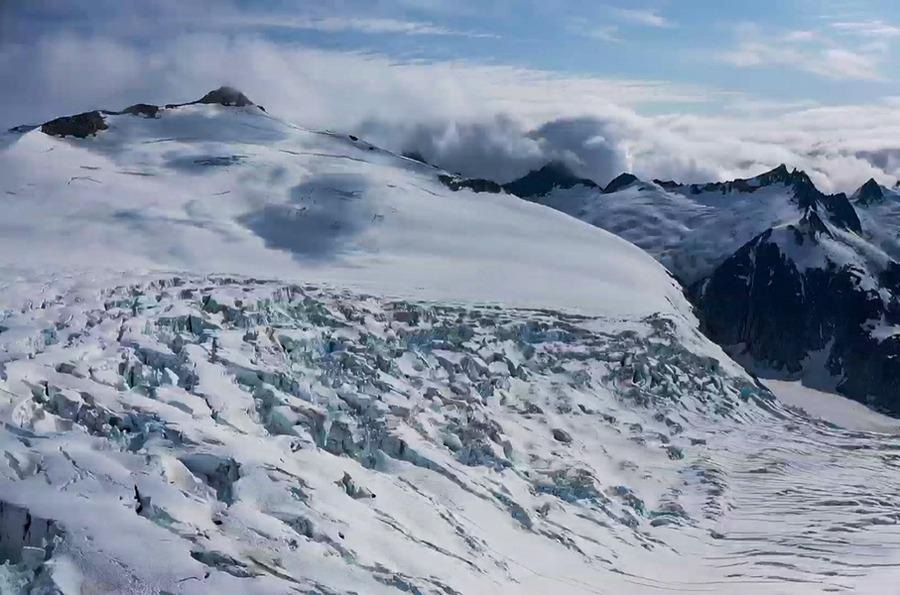According to a new study performed by the researchers of the Massachusetts Institute of Technology (MIT), the rate of glacier ice flow seems to be highly sensitive to stress compared to what was initially calculated. This overturns a decade-old equation that explains ice flow.
 The rate of glacier ice flow is more sensitive to stress than previously calculated, according to a new study by MIT researchers that upends a decades-old equation used to describe ice flow. Pictured is the Juneau ice field in Alaska. Image Credit: Joanna Millstein.
The rate of glacier ice flow is more sensitive to stress than previously calculated, according to a new study by MIT researchers that upends a decades-old equation used to describe ice flow. Pictured is the Juneau ice field in Alaska. Image Credit: Joanna Millstein.
Here, stress relates to the forces acting on Antarctic glaciers, which are mainly impacted by gravity that drags the ice down toward lower elevations. Viscous glacier ice flows “really similarly to honey,” states Joanna Millstein, a Ph.D. student in the Glacier Dynamics and Remote Sensing Group and the study’s lead author.
If you squeeze honey in the center of a piece of toast, and it piles up there before oozing outward, that’s the exact same motion that’s happening for ice.
Joanna Millstein, Study Lead Author and PhD Student, Glacier Dynamics and Remote Sensing Group, Massachusetts Institute of Technolgy
The modification to the equation suggested by Millstein and her collaborators must enhance models for making predictions on the ice flow of glaciers. This may help glaciologists foretell how Antarctic ice flow might add up to future sea-level rise, though, Millstein stated that the equation change is unlikely to increase estimates of sea-level rise beyond the maximum levels predicted under climate change models.
Almost all our uncertainties about sea level rise coming from Antarctica have to do with the physics of ice flow, though, so this will hopefully be a constraint on that uncertainty.
Joanna Millstein, Study Lead Author and PhD Student, Glacier Dynamics and Remote Sensing Group, Massachusetts Institute of Technology
The other authors of the study include Brent Minchew, the Cecil and Ida Green Career Development Professor in MIT’s Department of Earth, Atmospheric, and Planetary Sciences, and Samuel Pegler, a university academic fellow at the University of Leeds. The study was published in the journal Nature Communications Earth and Environment.
Benefits of Big Data
Glen’s Flow Law, the equation in question, is the most extensively utilized equation to explain viscous ice flow and was developed by British scientist J.W. Glen in 1958. According to Millstein, Glen was one of the few glaciologists working on the physics of ice flow in the 1950s.
With comparatively few researchers working in the field until recently, together with the inaccessibility and remoteness of the majority of large glacier ice sheets, there were few attempts made to calibrate Glen’s Flow Law outside the laboratory.
In the study carried out recently, Millstein and her collaborators took advantage of a new wealth of satellite imagery over Antarctic ice shelves, the floating extensions of the continent’s ice sheet, to revise the flow law’s stress exponent.
In 2002, this major ice shelf [Larsen B] collapsed in Antarctica, and all we have from that collapse is two satellite images that are a month apart. Now, over that same area we can get [imagery] every six days.
Joanna Millstein, Study Lead Author and PhD Student, Glacier Dynamics and Remote Sensing Group, Massachusetts Institute of Technolgy
The new analysis illustrated that “the ice flow in the most dynamic, fastest-changing regions of Antarctica—the ice shelves, which basically hold back and hug the interior of the continental ice—is more sensitive to stress than commonly assumed,” stated Millstein.
Millstein is positive that the growing record of satellite data will help apprehend quick changes in Antarctica in the future. This offers an understanding of the underlying physical processes of glaciers.
However, stress is not the only factor impacting the ice flow, noted the scientists. Other parts of the flow law equation represent variations in ice grain size and orientation, temperature, and impurities, and water contained in the ice — all of which could alter flow velocity. Factors like temperature could be significant in comprehending how ice flow affects sea level rise in the future, stated Millstein.
Cracking Under Strain
Furthermore, Millstein and collaborators are investigating the mechanics of ice sheet collapse, involving different physical models compared to those utilized to understand the issue of ice flow. “The cracking and breaking of ice is what we’re working on now, using strain rate observations,” stated Millstein.
The scientists utilized InSAR, radar images of the Earth’s surface gathered by satellites, to note deformations of the ice sheets that can be utilized to make accurate measurements of strain. The researchers hope to better comprehend the rate at which crevasses and rifts propagate to induce collapse by noting areas of ice with high strain rates.
This study was financially supported by the National Science Foundation.